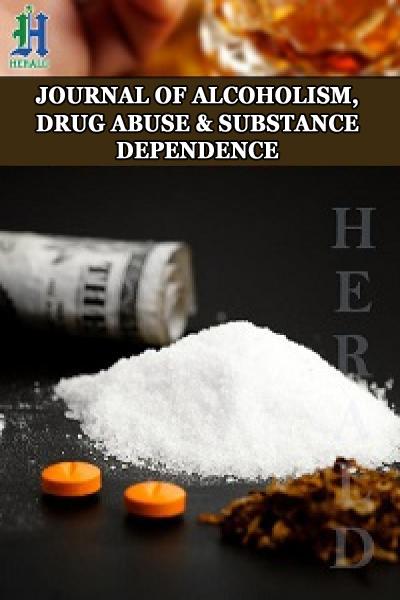
Experiences and projections for Drug Abuse Sensitization and Eradication among youths in South West, Nigeria
*Corresponding Author(s):
Ogunsola SOFood And Genes Initiative Team (FAGI), Nigeria
Tel:+2348102443104,
Email:Samuel_ogunsola@yahoo.com
INTRODUCTION
Drug abuse is a global health and social problem with distinct conditions and problems that vary locally [1]. The use of psychoactive substances among adolescents and youths has become a subject of public concern worldwide due to the fact that it contributes potentially to deliberate or un deliberate harm/injury [2,3]. Drug abuse, addictions and trafficking has a universal propaganda that transverse across socioeconomic, cultural, religious, and ethnic boundaries [4]. Despite the efforts of the Nigerian tiers of Government and the National Drug Law Enforcement Agency (NDLEA) to stem to its tide in Nigeria, there has been a consistent spate in the number of cases especially among adolescents (10-25 years of age) [5]. Experimentation with drugs during adolescence is common in Nigeria. At this age, they desire to explore many things due to several factors like: curiosity, peer pressure and to relieve stress. Using gateway drugs especially alcohol and tobacco due to early exposure increases the risk of using other hard drugs later. Some adolescents experiment and stop or continue to use occasionally without having negative complications. Others develop addiction that makes them move into more dangerous drugs and causing significant harm to themselves and possibly others: family and community (National Institute on Drug Abuse 2003).
CONCEPT OF DRUG ABUSE OR MISUSE
There is a misconception about the terms “drug abuse” and “drug misuse”. It is important to know as both concepts are pivotal in drug abuse therapy. Contextually, drug abuse describes the non-medical, self-administration of a substance to induce psychoactive effects, intoxication or altered body image, despite the knowledge of its potential adverse effects while drug misuse implies that a drug has a proper medical use and prescription and is being employed for an incorrect purpose [6]. The well noted examples of drug misuse are observed in cases of self-prescription and drug overdose. These comes with grave consequences such as altered metabolism and several systemic organ dysfunctions. One major consequence of drug abuse is dependence and addiction, characterized by compulsive drug cravings seeking behaviors and use that persist even in the face of negative consequences. These changes are maladaptive and inappropriate to the social or environmental settings, therefore may place the individual at risk of harm [7].
PREVALENCE OF DRUG ABUSE AMONG YOUTHS IN NIGERIA
The use of drugs for social rather than prescribed medical reasons has been well documented [8,9]. A comparison with other third world countries reveals that Nigeria ranks among the highest users of dangerous drugs such as alcohol, tobacco, cannabis, benzodiazepines, cocaine and opioids [10]. A review of the literature clearly indicates that there has been a steady increase in the prevalence of drug use and its associated consequences within the last three decades [11-13]. Almost all types of psychoactive substances are available in Nigeria due to their spill over into the streets from drug traffickers who use Nigeria as a conduit to transport drugs from South East-Asia (the Golden Triangle) and South America (Boliva, Peru, and Brazil) to Europe and North America [14].
There is high prevalence among youths especially students [15]. The desire to explore, experiment and peer pressures are factors responsible for these prevalence. According to a research carried out in University of Lagos, Nigeria using a WHO student drug survey proforma. Of the 1000 students surveyed, a total of 807 responded to the questionnaire resulting in 80.7% response rate. Majority (77.9%) of the students were aged 19-30 years and unmarried. Six hundred and ninety-eight (86.5%) claimed they were aware of drug abuse, but contrarily they demonstrated poor knowledge and awareness. Marijuana, 298 (45.7%) was the most common drug of abuse seen by most of the students. They were unable to identify very well the predisposing factors to drug use and the attending risks. Two hundred and sixty-six (33.0%) students were currently taking one or more drugs of abuse. Coffee (43.1%) was the most commonly used drug, followed by alcohol (25.8%) and marijuana (7.4%). Despite chronic use of these drugs (5 years and above), addiction is not a common finding [16].
CONSEQUENCES OF DRUG ABUSE IN NIGERIA
Drug abuse is one of the health-related problems among Nigerian youth and has been a source of concern to national stakeholders. Drug abuse among Nigerian youth has been a scourge to the overall sustainable development of the nation. Substance abuse is a serious issue; a global and international issue particularly in developing countries like Nigeria. Drug abuse is also a major public health, social and individual problem and is seen as an aggravating factor for economic crises; hence, for Nigeria’s poverty status. While youth are supposed to be the major agent of change and development, some of them have been destroyed by drug abuse (rendering them unproductive). Drug abuse has become a global concern in Nigeria because of its effect on youth and the nation as a whole. Drug abuse has a negative impact on the education of undergraduates in different universities across the globe. The overall health of the user is affected negatively and behaviors associated with drug abuse predispose the abuser to crime and contagious diseases including HIV/AIDS (Center for Disease Control, 2000).
Drugs are used for a variety of reasons. A number of effects were established by a number of researches. Physical effects of substance abuse include liver cirrhosis, pancreatic, peptic ulcer, hypertension, neurological disorder, tuberculosis, etc. Also, mental effects consist of retardation, growth deformity, nervous system deficiency, delayed motor development, amnesia and dementia among others [17]. The various consequences of drug addiction or drug abuse are so devastating and very shameful to the extent that both the nation and international organizations all over the world are also worried about the spread of this scourge among the youths.
• Mental disorder, social violence, gang formation, cultism, armed robbery, 419 syndrome, internet frauds, social miscreants (area boys and girls) lawlessness among youths, lack of respect for elders, rape, loss of senses, instant death and wasting of precious and innocent lives and many more [18].
• The effect produced by smoking tobacco depends on the nicotine that is absorbed from the smoke. Many of the students graduate from tobacco smoking to Marijuana smoking, which they believe it will be more powerful on them and make them hyperactive. It is cheap and can easily be purchased from drug peddlers that are increasingly targeting the youth, as a symbol of revolution. Drug addicts may become a nuisance to the society, problems to themselves and their family members. There are distinct changes in the physical appearance, behavior and the general health of an addict. Such changes may include emaciated and malnourished look, neglect of personal hygiene and unkempt appearance. From homes, drug addicted adolescents associate with fellow addicts. Drug habit is not only expensive, it is also difficult to sustain.
• The social problem of substance abuse among the youth (male and female) has in most cases resulted in low, moderate and high physical and psychological dependence leading to a complete withdrawal from schools and the emergence of future criminals and illiterates in the society [19].
• Similarly, the side effects of codeine over use involve: loss of pleasure in favorite activities and hobbies, lack of will in doing simple things in life, indifference toward family, events, or loved ones, decreased interest in sex and affection, loss of professional or personal drive, unawareness of how behavior and emotional distress. Additional signs of clinical depression include: anger, emptiness, irritability and sadness, or self-criticism, loss of appetite, fitful sleep, lack of sexual drive, increased erectile dysfunction.
• Apart from the aggravated side effect there is also the common adverse codeine side effects include constipation, dizziness (orthostatic hypotension), drowsiness, dry mouth, erectile dysfunction, euphoria ,headache, sleeplessness (insomnia), itching, rash ,lack of sexual drive, nausea, vomiting, pinpoint pupils (miosis), sweating, urinary retention.
THE 365DAYS PROJECTS AND INTERVENTION
Food and Genes Initiative is a non-governmental organization founded in December, 2017 in Nigeria with the purpose of improving the wellbeing and lifestyle of Africans through advocacy, technology and research. The major objective of the organization is to reduce the prevalence of non-communicable disease, malnutrition and substance abuse in the continents. Their projects are more focused on creating awareness on factors that lead to these health issues. In view of this, they started a one year campaign project in December 2018 called 365 DAYS which is an acronym for 365 days of Drug Abuse Youth Sensitization. The campaign was mainly carried out in Nigeria with the aim of reducing tobacco use and alcoholism in the country. The campaign involves 365 days of social media sensitization and offline campaigns targeted on youth and teenagers in the country.
The organization partnered with more than 16 other organizations which include Young African Leadership Initiative Alumni Network, Nigeria, One Voice Initiative, MORE foundation, Junior Chamber International, We Care Foundation and others in the country to execute the project. On international collaboration, In January 2019, Food and Genes Initiative partnered with National Institute on Drug Abuse, USA to take part in the “National Drug and Alcohol Facts Week” for teenagers across 6 states in Nigeria, reaching out to more than 20,000 teenagers [20]. Also, they received free materials from Drug Free World, USA to facilitate programs for teenagers across 30 schools in Lagos, Nigeria.
EXPERIENCES AND IMPACTS OF THE CAMPAIGN
The application of internet in carrying out campaign works cannot be over emphasized in this decade. Campaigns such as the Me Too, Balance The Equation for gender equality and Climate Change won’t have been successful without the applications of digital tools [21]. Many activities such as learning, businesses, and corporate affairs have been moved online with many organizations leveraging on this to drive their impacts. Facebook, popular social media platforms has billions of users that can easily be engaged with on important information [22]. In Africa, more than 226 million young people between ages 20 -24 years have access to internet and this figure will continue to on the rise [23]. In this millennial age, it is important that the platforms are loaded with correct and ethical information that will help young people develop balanced lifestyle and wellbeing.
ONLINE CAMPAIGN
The 365 DAYS project is the longest ever online campaign on drug abuse in Nigeria. The hashtags used include #365days_fagi, and Say No To Drug Abuse was able to create hundreds of thousands of impressions and engagements on social media platforms. The organization designed a campaign plan that include all the themes they will release into the media weekly and strategies for disseminating the contents on the media platforms. The themes were designed in respect to related health issues celebrated internationally each month (Figure 1).
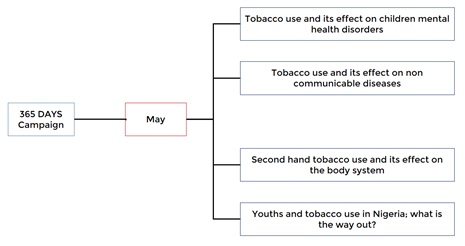 Figure 1: The 365days campaign strategy
Figure 1: The 365days campaign strategy
The one year campaign was divided into 12 based on the number of months in a year and further divided into 52 based on the number of weeks in a year. For the month of May described above, it is the world tobacco day month and all the themes we focused on tobacco use and its effects. The 365 DAYS online campaign team consists of Content writers, Psychologists, Public Speakers, Graphic Designers, Social Media managers and volunteers. At the start of the campaign, the organization rolled out an online form to call for volunteers that are interested in the project. They made sure they had previous knowledge on health related issues and good social media presence. The campaign started with a volunteer base of 450 people and a core team of 7. The organization ensure all the team are involved in the campaign and also take part in regular trainings on the cause, this helped in building advocates that stand against drug abuse in their communities. The main platforms used for the campaign include Facebook, Twitter, Instagram, and Linkedin (Figure 2).
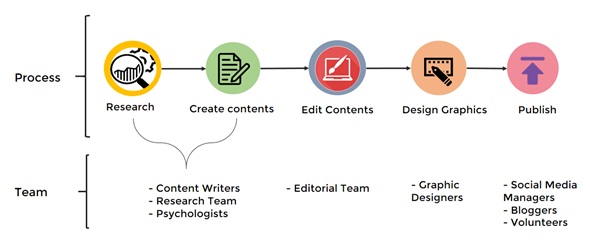 Figure 2: The 365days campaign sustainability model process and the teams involved
Figure 2: The 365days campaign sustainability model process and the teams involved
The research team work on creating contents based on the theme for the week, transfer it to the editorial team to edit and then transfer to the graphic designers to create a graphical presentation that will be posted by the publicity team.
The main social media platform for the campaign is Twitter. The platform is a very good place to engage people and reach thousands through the help of retweeting the post and liking them. Besides, Twitter has a good analytical tool that helps to know the rate of engagement and impressions of our post. As seen in (Figure 3 and 4) the rate of impression and engagement at the beginning of the campaign was low, because the team had to look into increasing the number of the followers first. Tweet chats were organized regularly by the team to discuss about substance abuse and health related issues which helps significantly in increase the engagement and impression rate.
The figures given below were from the social media page of the organization, more than 15 other organization used their page in carrying out the campaign.
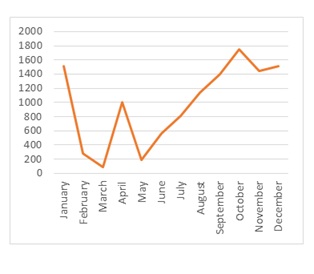 Figure 3: 365days twitter engagements
Figure 3: 365days twitter engagements
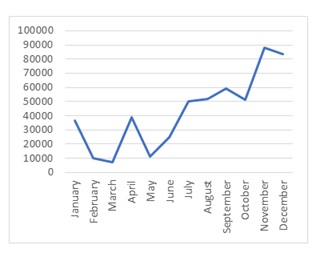 Figure 4: 365days twitter impressions
Figure 4: 365days twitter impressions
Aside from the high rates of impressions and engagements recorded from the campaign, the team was able to help people that are addicted to substance abuse through one on one counselling using the social media. An important case was a young man addicted to tramadol that saw the campaign post on twitter. He made use of the messaging tool on the platform to engage the team and he was connected to a rehabilitation center close to his place of residence to receive the required treatment. The counselling team followed him up regularly to know how he is feeling and also encourage him to take his treatment.
OFFLINE CAMPAIGNS
A major challenge attached with the online campaign is the fact that many youths are that are taking drugs are not on social media and reaching out to teenager will not be effective because a majority of them don’t have access to phones. To address this, the 365 DAYS campaign team organized offline projects, which involves stepping out to engage people face to face and sensitize them on the effects of substance abuse. The major projects organized are described below:
National drug and alcohol facts week (NDAFW) campaign : This is the first offline project organized by the 365 DAYS campaign team and it was in partnership with National Institute on Drug Abuse [24], USA. The aim of the project is to reach out to teenagers and sensitize them on the facts about substance abuse. The World Health Organization reported that 9 out of 10 drug abusers had contact with it when they were teenagers. In Nigeria, most of the children above age 6 already know about marijuana, cigarette and alcohol and this is caused by what they see on media, what their parent do and what is happening in the communities. The team made use of the free materials distributed by NIDA to sensitize the students. The team was able to organize the project across 6 states in Nigeria which include Oyo, Ondo, Ekiti, Delta, Lagos and Ogun State. There focus was on secondary schools because that’s where they can easily engage teenagers. They visited about 15 schools reaching out to more than 20,000 teenagers. The project was published in the NIDA report and uploaded on their Flickr page.
Community outreaches: In Nigeria, alcohol and marijuana use is very high in the rural communities because of easy access to the substance and lack of knowledge about the negative impacts on the user’s health. The 365 DAYS team partnered with Slum and Rural Health Initiative (SHRIN); a nonprofit organization focused on creating health interventions in rural communities. The 365 DAYS team focus on counselling community members on the negative effect of drug abuse while SHRIN works on carrying out medical checkups to know their diabetic status and blood pressure. The first community outreach was carried out in Owode Local Government at Ogun State, Nigeria. The team was able to engage about 100 youths and carryout checkup for 75 community members. The youths were handed over to the community leaders to monitor them and always sensitize them about negative effect of substance abuse.
Teenagers against drug abuse project: The teenagers against drug abuse project is focused on empowering young people that will stand in as advocates of substance abuse in their respective communities. The project was carried out in secondary school in Lagos State, Nigeria with the aid of National Youth Service Corps Sustainable Development Group (NYSC SDGs) and Drug Free World, USA. The team was able to visit about 30 schools in the state, distribute free materials such as booklets and videos from Drug Free World to them and create Drug Abuse Clubs where the teenagers can carry out their advocacy roles. The team visits the schools weekly to check the effectiveness of the clubs and address issues that are related to substance use amidst the students.
Street conferences: The 365 DAYS team organized street based awareness program that involved going to strategic places where young people gather to take substances. The team engage them without stigmatization and share fliers containing facts on drug abuse with them. The program was carried out in Ibadan, Oyo State and Akure, Ondo State Nigeria reaching more than 300 people.
CHALLENGES FACED DURING THE CAMPAIGN
The 365days campaign project was a great success because most of the objectives defined at the beginning of the project were achieved. However, challenges were encountered by the team especially when organizing the offline projects. Some of them are discussed below;
• Funding: The major source of funds for the project were personal funds, in kind support free materials from international organization and partnerships with other organizations. The funds were not enough to effectively scale the project to other geopolitical zones in the country and this limited the reach of the team. Also, the online campaign would have been more effective if digital marketing tools are used in creating awareness on social media. In addition, the team members did not receive salaries all through the project and this reduced their morale.
• Lack of affordable rehabilitation centers: Despite the fact that substance misuse is a major issue that influences numerous Nigerians, there are still not many rehabilitation centers in the country. Nigeria needs appropriate clinical recovery centers for those experiencing alcohol and medication misuse. What's more, a portion of the techniques used to treat addicts at the couple of recovery focuses in the nation are reprimanded as insensitive.
FUTURE PROJECTIONS AND RECOMMENDATIONS
The curbing of drugs involves the collaborative efforts of all stakeholders – Government, Drug Control Agencies, Community, Schools etc. The following projections are suggested to help reduce drug abuse among adolescents and youths in Nigeria:
• Educating family units on drugs: The family is the nucleus of every society. Parents should be encouraged to get drug education and teach their children as part of health, moral and character development. They should also inform them of the use, abuse and the danger of drugs to individuals and the society.
• Establishment of counseling centers for drug control: Counseling centers should be established in every community by the government or private individuals. Qualified health counsellor should be employed in helping drug addicts or those dependent on drugs by giving them special advice on how to go about the withdrawal system.
• Designing curricula on drug education: Ministry of education (State and Federal) should as matters of urgency add to the curricula- drug education at all levels of education.
• Campaign against drug abuse: National Drug Law Enforcement Agency (NDLEA) should intensify their campaigns on antidrug in order to have a drug free society. The campaign against use of certain drugs and misuse of drugs should be more intensified at the secondary school level because it is the peak of adolescent. Also, government and other relevant authorities should lunch out campaigns against drug abuse as well as dependence.
• Establishment of drug awareness units: Drug awareness units to be set up in all states and moderated by the federal state and local governments. It should not be a panel established to try people who use drugs as criminals, but to help solve their socio-psychological problem.
• Ban of drugs selling points: The State and Local governments should ban joints and recreational centers known to be selling points for illicit substances and ensure that uncompleted buildings that are hide-out for the consumption and sale of illicit substances are completed by the owners or risk demolition.
• Establishment of drug rehabilitation centers: This is important for drug abusers, dependants and drug addicts in other to get medical treatment to restore their body physiological and psychological functions.
CONCLUSION
Medication misuse is a problem that is making genuine concern for both individuals and the Government everywhere throughout the world. The issue is predominant among young people who much of the time are uninformed about the perils inborn in medicate misuse. A large number of them occupied with in drug abuse out of disappointment, destitution, absence of parental management, peer impact and pleasure. Notwithstanding, with viable guiding system, the issues can be handled.
AUTHOR’S CONTRIBUTION
Author S.O.O., A.E.A. and E.A.F. drafted the 1 year campaign plan and schedule. FAGI team actively executed the online and offline campaign across some major states in Nigeria. Author S.O.O., E.A.F. and FAGI team conducted the procedures, validations and data acquisition. Author A.E.A. and A.A.T did the compilation, analysis and interpretation of the campaign’s impact across the states involved. All authors and FAGI team did critical revision to structure the content intellectually and approved the final version of the manuscript.
COMPETING INTEREST
The authors have declared have no competing interests.
REFERENCES
- WHO Expert Committee on Drug Dependence (1987) Twenty-third Report (Geneva: World Health Organization) Tech. Rep.Ser.No: 741.
- Whichstrom L, Hegna K (2003) Sexual orientation and suicide attempt: a longitudinal study of the general Norwegian adolescent population. J Abnorm Psychol 112: 144-151.
- Daane DM (2003) Child and adolescent violence. Orthop Nurs 22: 23-29.
- Oyakhilome F (1990) Perspective and Strategies in the control of the Traffick in Narcotics Drugs and Psychoactive Substances. In Kalu and Osibajo (Ed.) Narcotics: Law and Policy in Nigeria. Federal Ministry of Justice, Lagos, Pg no: 1-6.
- National Drug Law Enforcement Agency (NDLEA), 1992 and 1993 Drug Collection, Lagos. Drug Demand Reduction Unit.
- American Psychiatric Association DSM-IV, (1994) 23 Diagnostic and Statistical Manual on Mental Disorders. American Psychiatric Association, Washington DC, 175-184. J Med Sci 34: 355-359.
- American Psychiatric Association Practice Guidelines, (2006) Treatment of patients with substance use disorders, 2nd Am J Psych 163: 1-82.
- Fareo DO (2012) Drug abuse among Nigerian adolescent’s strategies for counselling. Int J Soc Res Methodol 20: 341-347.
- Bonomo YA, Bowes G, Coffey C, Carlin JB, Patton GC, et al. (2004) Teenage drinking and the onset of alcohol dependence: a cohort study over seven years. Addiction 99: 1520-1528.
- Degenhardt L, Chiu WT, Sampson N, Kessler RC, Anthony JC, et al. (2008) Toward a global view of alcohol, tobacco, cannabis, and cocaine use: findings from the WHO World Mental Health Surveys. PLoS Med 5: e141.
- Ihezue UH (1988) Drug abuse among medical students at a Nigerian university: Part 1. Prevalence and pattern of use. J Natl Med Assoc 80: 81-85.
- Oshodi O, Aina O, Onajole A (2010) Substance use among secondary school students in an urban setting in Nigeria: prevalence and associated factors. Afr J Psychiatry 13: 1-3.
- Dewing S, Pluddemann A, Myers BJ, Parry CD (2006) Review of injection drug use in six African countries: Egypt, Kenya, Mauritius, Nigeria, South Africa and Tanzania. Abingdon Engl 13: 121-137.
- Klein A (1994) Trapped in the traffic: growing problems of drug consumption in Lagos. J Mod Afr Stud 32: 657-677.
- Okafor EE (2011) Youth unemployment and implications for stability of democracy in Nigeria. JSDA 13: 358-373.
- Oshikoya A, (2006). Perception of Drug Abuse among Nigerian Undergraduates. WJMS 1: 133-139.
- Mba AI (2008) Counseling Techniques for the rehabilitation of Drug Addicts in Nigeria. The Counselor 18: 10-18.
- Dankani IM (2012) Abuse of Cough Syrups: A New Trend in Drug Abuse in Northwestern Nigeria States of Kano, Sokoto, Katsina, Zamfara and Kebbi. Int J Phy Sci 2: 101-115.
- Schmalleger F (2006) Criminology Today: An Integrative Introduction. Third edition, New York Prentice Hall Publishers.
- NIDA (2019) International Organizers “Shatter the Myths” Through NDAFW.
- Saxton GD, Niyirora J, Guo C, Waters R (2015) Advocating For Change: The strategic use of hashtags in social media advocacy. Adv Soc Work 16: 154-169.
- Glassman D (2020) Facebook is creating records-but who is managing them? Archives and Manuscripts 48: 45-58.
- Internet World Stats- Internet Users in the world by regions 2020.
- National Institute on Drug Abuse (NIDA), (2003) 25 National Institutes of Health -U. S Department of Health and Human Services: Preventing drug use among children and adolescents, 2nd Ed.
Citation: Ogunsola SO, Fajemisin EA, Aiyenuro AE, Tunde AA (2020) Experiences and projections for Drug Abuse Sensitization and Eradication among youths in South West, Nigeria. J Alcohol Drug Depend Subst Abus 6: 018.
Copyright: © 2020 Ogunsola SO, et al. This is an open-access article distributed under the terms of the Creative Commons Attribution License, which permits unrestricted use, distribution, and reproduction in any medium, provided the original author and source are credited.
